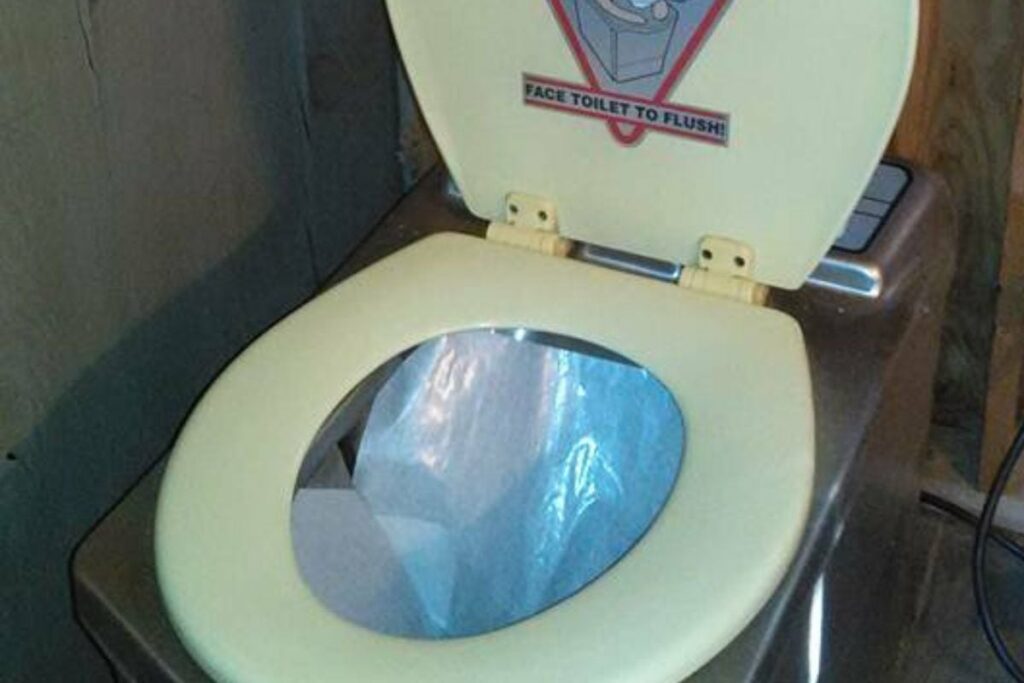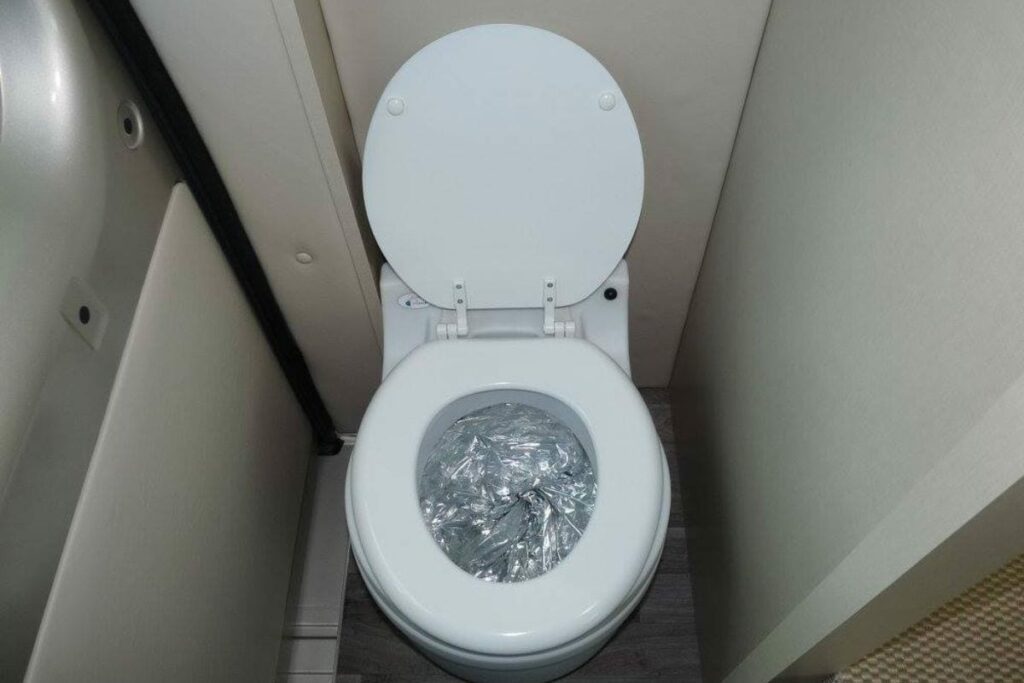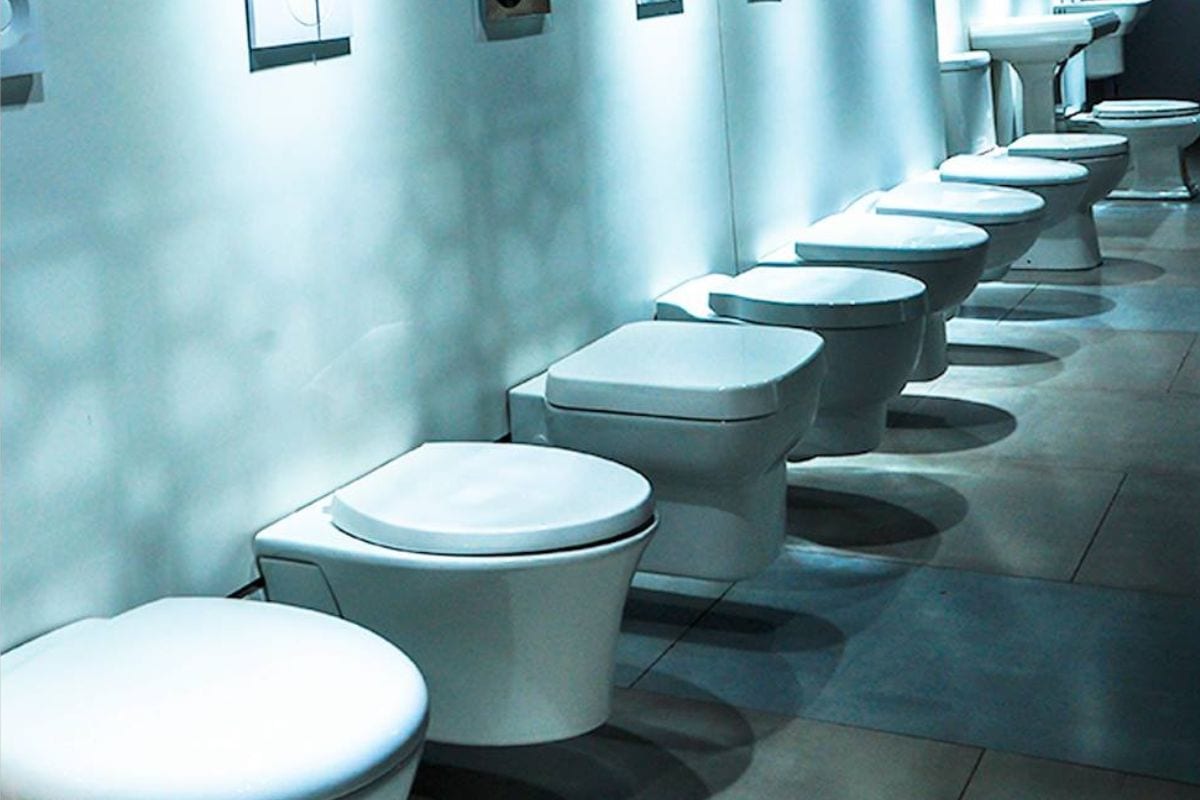The shape and look of toilets vary around the world, and there are many different types that have a range of advantages and disadvantages. Today, I will explain the different types of toilets, and how they work.
There is one main type of toilet, a gravity flush toilet (regular toilet). But, it has 9 different variations. The 9 variations of a regular toilet are rimmed, rimless, one-piece, two-piece, wall-mounted, floor-mounted, skirted, non-skirted, floor-level toilets, and pressure-assisted toilets.
There are also 6 non-conventional toilets such as a composting toilet, and a portable toilet that you see and concerts and on construction sites typically called a port-a-loo. These each have different flushing mechanisms, and some don’t flush at all. Below, I will cover a rundown of the different types of toilets, and end with what type of toilet is the best overall.
Rimmed and Rimless toilets

Rimmed toilets are the most common, these are the toilets you will find almost everywhere and have a rim around the top of the bowl. The water flows from the water tank out through holes on the underside of the rim, and then into the bowl.
There are now what are called rimless toilets. The water comes out from one large hole at the rear or side of the bowl. And is located near the top of the bowl. It has about a 2-inch (5 cm) lip that sticks out around the top of the bowl.
Which stops water from overflowing over the top of the bowl. The advantage of these is, that they are far easier to clean than a rimmed toilet.
The way the water enters the bowl also cleans the bowl more thoroughly, which reduces the risk of leaving poop residue on the sides of the toilets. Which will then need to be cleaned with a toilet brush.
Pressure assisted toilets

A pressure-assisted toilet has a mechanism that causes the water to enter the bowl with more force. Interestingly, it doesn’t use any electricity and uses air pressure instead. The pressure-assisted mechanism is quite large and takes up most of the water tank.
The disadvantage of a pressure-assisted toilet is it’s slightly louder than a regular toilet. This can be an issue when the toilet is used late at night.
But, all things considered, it’s far better than a regular flushing toilet because it reduces the risk of clogs in the exit pipe underneath the toilet. There is also a slight variation of a pressure-assisted toilet which is a vacuum flush toilet. It has the same effect as a pressure-assisted toilet. In my opinion, it’s surprising that more toilets aren’t pressure-assisted.
One-piece vs Two-piece toilets
A regular toilet has a tank that sits above the bowl and is visible. These are different from wall-mounted toilets that have the water tank inside the wall. More on this later. Toilets with a water tank above the bowl are of two broad types 1) one-piece, and 2) two-piece.
A two-piece toilet has a water tank that is separated and is connected to the bowl by one pipe. You can tell them apart from a one-piece toilet because there is a space in between the bowl and the water tank.
The disadvantage of a two-piece toilet is that urine can get into this space, and be difficult to clean. A one-piece toilet by comparison has no space at the base of the water tank, and the toilet is – as the name suggests – one piece.
Wall-mounted and floor-mounted toilets
The most common type of toilet is floor mounted. These are where the base of the toilet is bolted into the floor. The other main type of toilet is a wall-mounted toilet. A wall-mounted toilet has no visible water tank, and comes out directly from the wall, without touching the floor at all.
A wall-mounted toilet creates a floating visual effect, and for some people’s tastes, it looks more visually appealing. However, it can feel a bit uncomfortable because it doesn’t look very sturdy.
Overall, though they’re easier to clean and are more hygienic. The water tank for a wall-mounted toilet is located behind the wall. This does mean it’s a bit more tricky to repair if there is an issue with the water tank. Here’s a short video that shows how a wall-mounted toilet is fitted and installed:
Skirted and non-skirted toilets
Skirting on a toilet is the area of the toilet at the base. If a toilet is skirted it has a flat base that curves inwards and then up. Whereas, a non-skirted toilet is flat and goes from the rim all the way to the floor at a vertical angle. A non-skirted toilet is easier to clean and looks more minimalist, which you may like.
The reason is with a skirted toilet, any accidents can sit in the grooves on the skirt of the toilet. On the other hand, with a non-skirted toilet, there is only one flat surface to wipe down.
Toilets that are level with the floor
A far less common type of toilet is a toilet that is level with the floor. These types of toilets are common in India, and parts of Asia. But, can be found here and there in English-speaking countries.
Using this type of toilet to take a poop requires a person to squat down. Or, if a female is using one to urinate they also squat down. Most people find this type of toilet more difficult to use because you can’t sit down.
Dual flush and single flush

This is not technically a unique type of toilet but is a broad difference. Many toilets only have one option to flush which does a full flush. Which empties the entire water tank. Others have two buttons. One for a half flush and one for a full flush. A half flush toilet conserves more water than a full flush. And is better when it’s used to just go number 1.
Non-flush toilets – 5 main types
There are 5 main types of toilets that don’t use water to flush them. These are:
- Portable toilets
- Incinerating toilets
- Dry flush toilets
- Composting toilets
- Dig a hole toilets
Portable toilets
These types of toilets are common on construction sites, and at concerts and events. They are a large area filled with chemicals to reduce the smell. And also have a separate compartment where men can urinate. These get filled up and then eventually get hauled off to be emptied. In other cases, there is a special truck that will come by and suck out all of the waste.
Incinerating toilets
An incinerating toilet is ideally suited to a home that doesn’t have access to residential sewer lines. Such as in remote areas. Using these in a tiny house is also common. They have a very interesting and innovative design.

When you use it you put a piece of paper that covers the interior of the bowl. Then after you flush it, it falls down into a catchment tray. It is then burned up very slowly. And the fumes are taken away through a vent that blows on the exterior of a house.
These types of toilets are very good for houses that can’t connect to the city sewer lines. Or, as an off-grid solution that is fully self-contained. I explained what an incinerating toilet is and how it works in more detail in this article about composting toilets vs incinerating toilets.
Composting toilet
A composting toilet does not ‘flush’ per se. A composting toilet is a self-enclosed container that has either peat moss or coconut core fiber. Some people also spray these with an organic nice smelling scent.
After you use a composting toilet you turn a crank that mixes the waste with the peat moss, or coconut core fibers. This spreads it out and makes it easier for bacteria to break it down. Then after a significant amount of use – around 50 or so the fiber and waste turns into soil. It can then be dumped out into the garden, or a compost pile.
Dry flush toilet
A dry flush toilet is a very unique design. It has a metallic-looking bag in the bowl that collects what you put into (poop, and pee). After you use it you press the flush button.
When this happens the motor on a dry flush toilet rotates the bag while holding the top of the bag still. It turns it in such a way that it seals off perfectly what you put into it from the rest of the bag.
It then opens the remainder of the bag above what it has twisted closed so that it can be used again. This stops a dry flush toilet from smelling.

One criticism of a dry flush toilet is that the bags are quite expensive. So, it has a higher operating cost them some of the other no-flush toilets. After the bag in a dry flush toilet is full, you can simply put it out with the trash.
Dig a hole toilet
A dig a hole toilet is simply that, when you need to go poop, you dig a hole, do a poop, and then bury it again. How exactly you dig the hole is a matter of personal preference. And if you’re somewhere for a few days, you can find a place quite far from where you are, and use the hole multiple times.
This works particularly well for camping, or areas where there are no public toilets, or it’s deemed too difficult to install a permanent toilet. But, it does depend on the area being reasonably remote.
It’s worth planning where you will go so that others don’t accidentally go in the same area. Doing so could mean you dig up where someone else has been. It’s also a good idea to spread out where you go because it takes about 1 year for poop to completely break down.
What You Need To Know Before Buying a Toilet
There are a range of different toilet styles, and it seems like any toilet will do the job. But, there are a few things that are better about certain types of toilets. Here’s what you should consider before buying a toilet.
Overall, the key considerations are whether to get a rimmed or rimless toilet, a pressure-assisted, or non-pressure assisted toilet, a wall-mounted or floor-mounted toilet, a skirted or non-skirted toilet, and a one-piece or two-piece toilet.
Each of these has an effect on how well a toilet performs, and how well easy it is to clean. In general, one-piece toilets, non-skirted toilets, and wall-mounted toilets are more expensive. Therefore, the key consideration for whether you want to best toilet is where the toilet will be located. And if you are going to live in the house permanently or are renovating it to sell it.
The Best Type of Toilet
There are many different types of toilets to choose from, and there are a few key considerations such as whether to get a rimmed or a rimless toilet and if you should get a one-piece or two-piece toilet. Based on all the pros and cons, here’s the best type of toilet to get.
Overall, a rimless, one-piece toilet, that is pressure-assisted is the best. A wall-mounted toilet is more hygienic but is difficult to maintain if there is an issue with the water tank. The main reasons are that this type of toilet is easier to clean, and reduces the risk of clogs.
A rimless toilet cleans the bowl better, and there’s no rim which can be tricky to clean. A pressure-assisted toilet has more flushing power which cleans the bowl better and reduces the risk of clogs. And a one-piece toilet doesn’t have the space as the bottom of the water tank which can be difficult to clean.

Amos Christen graduated with a bachelor’s degree in Interior Design from Drexel University — Philadelphia, PA. Since 2003, Amos has worked with top interior design professionals in this area, including architects and interior/graphic/lighting designers. As a skilled interior designer, Amos Christen is highly versed in fine arts and crafts and uses that to supplement his main area of expertise. He often publishes articles related to home décor on several websites, including Sprucetoilets.com, Sprucebathroom.com, and Mybesuitedhome.com. He also contributes to leading interior design magazines.
